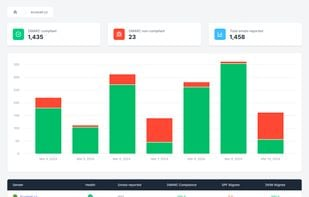User experience
DMARCEye boasts a user-friendly interface, making it accessible even for those who aren't deeply technical. We found the dashboard intuitive, presenting DMARC report data in an easy-to-digest format. The setup process is straightforward, allowing for quick onboarding.
However, like any DMARC tool, interpreting complex DMARC errors can still be challenging at times, a common hurdle not specific to DMARCEye but rather to DMARC itself. The AI-powered insights do help to demystify some of these complexities, guiding us toward resolutions effectively.
DMARC 25 provides a professional interface that, while not as openly showcased as DMARCEye, appears functional and robust. Given its enterprise-leaning approach, we anticipate a user experience designed for a more technically proficient audience, potentially with a steeper learning curve for newcomers to DMARC.
The initial setup and configuration might involve direct consultation, which ensures a tailored experience but might not offer the immediate, self-service onboarding that some users prefer. The experience is likely polished, but requires a more hands-on approach from their team during implementation.











































 4.5 / 5(1)
4.5 / 5(1)
 0 / 5(0)
0 / 5(0)



